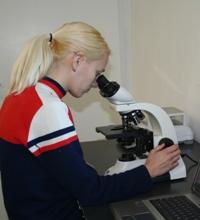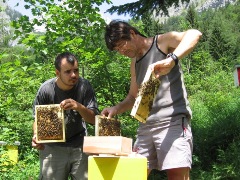ČEBELARSTVO
Brane
Kozinc
Hraše 1a 4248 Lesce
GSM.:+386 41 734
009
tel.: +386 4 533 32 03
fax.: +386 4 533
32 03
brane.kozinc@telemach.net

Our queens have allready been sent to:
-
Australia
- Estonia
-
Finland
- France
-
Spain
-
Austria
-
Bulgaria
-
Poland
-
Czech
-
Belgium
-
Portugal
-
Great Britain
-
Germany
-
Greece
-
Croatia
-
Bosnia
-
Serbia
-
Italy
-
Switzerland
-
Lithuania
-
Netherlands
-
Romania
- Sweden
- Turkey
- Slovakia
- Iran
|
Queen breeding

| Our beekeeping has a long-standing tradition. My grandfather’s great grandfather, Franc Vovk from Hraše, is mentioned for the first time in official documents as one of the founders of the Rodine beekeeping brotherhood. It was founded on 14 April 1781 and is the first known association of beekeepers in the world. |
|
 |
We breed pedigree queen bees of the Carniolan honey bee species (the Apis mellifera carnica). They are mating at my own queen breeding station which is located in the walley KRMA at the elevation of 1100 m and is surrounded by mountain peaks that are more than 2000 m. Sorting and selection have been taking place since 1947, when Franc Vovk set up a breeding station in the valley of the Draga River. |
| Ciril Jalen and Ivan Rodman relocated it to below the Zelenica in 1964. We maintain five independent genealogical lines. We are most proud of the two lines that we took over from Franc VOVK and Jan STRGAR. Both were large exporters of bee colonies and queen bees. Adam Kehrle also took brood material from both of them in order to breed the Buckfast hybrid bees. We also took over more than 40 year old lines from Ciril JALEN. We keep pedigree records for all the lines. |
 |
 |
We take special care when sorting drones. The most important trait when doing the sorting is gentle nature and the calm behaviour on the comb, the cleaning instinct, reduced swarming tendencies and honey yield. When making the final decision, the appearance as well as the cubital index and the length of the proboscis must be determined to be suitable. Each queen bee remains in the breeding hive until her own bees start hatching. |
These are then also inspected. This is made possible by the size of the mating nuc as the queen can lay up to 6000 eggs in it. The queens are also inspected for the presence of the Nosema apis spores.
Due to the conditions at the breeding station and the method of work, the first queen bees can be obtained in June. |
|
|
|